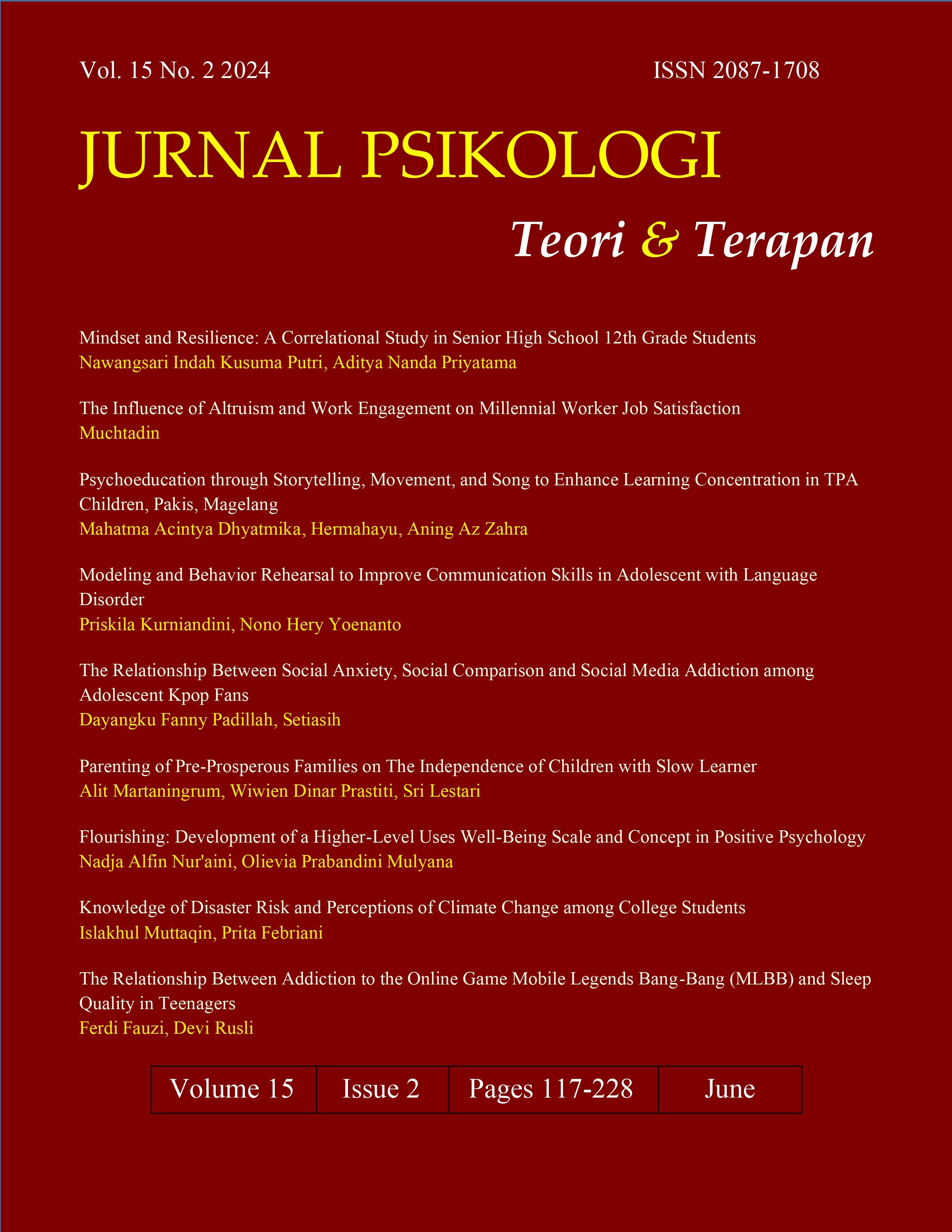Psychoeducation through Storytelling, Movement, and Song to Enhance Learning Concentration in TPA Children, Pakis, Magelang
DOI:
https://doi.org/10.26740/jptt.v15n02.p136-151Keywords:
Psychoeducation, storytelling, song and movement, learning difficulties, learning concentration, psikoedukasi, bercerita, gerak dan lagu, kesulitan belajar, konsentrasi belajarAbstract
Background: Children may face a difficulty in maintaining concentration during learning sessions, a factor that varies among individuals. At TPA (Quranic Education Center) Uswatun Khasanah Banyusidi, Pakis, Magelang, students also encounter issues with concentration and focus in their studies. Objective: This study aims to achieve several objectives: (1) assess the level of a child's learning concentration, (2) explore how psychoeducation, using storytelling, movement games, and songs, can improve a child’s concentration, and and (3) evaluate the effectiveness of psychoeducation in enhancing a child’s learning concentration. Method: The research adopts a classroom action research design, comprising two cycles. The process involves planning, implementing interventions, observing outcomes, and reflecting on results. Results: After Cycle 1, 41.02% of children met the expected development criteria, increasing to 79.48% in Cycle 2, with 53.84% meeting expected development and 25.64% demonstrating excellent progress. Conclusion: The use of psychoeducation through storytelling, movement, and songs at TPA (Quranic Education Center) Uswatun Khasanah Dayugo has successfully improved children’s learning concentration in each session.
Abstrak
Latar Belakang: Anak mungkin mengalami kesulitan dalam menjaga konsentrasi saat pembelajaran, faktor yang berbeda-beda pada setiap individu. Di TPA (Pusat Pendidikan Al-Quran) Uswatun Khasanah Banyusidi, Pakis, Magelang, siswa juga mengalami kendala konsentrasi dan fokus dalam belajar. Tujuan: Penelitian ini bertujuan untuk mencapai beberapa tujuan: (1) menilai tingkat konsentrasi belajar anak, (2) mengeksplorasi bagaimana psikoedukasi, dengan menggunakan bercerita, permainan gerak, dan lagu, dapat meningkatkan konsentrasi anak, dan (3) mengevaluasi efektivitas psikoedukasi dalam meningkatkan konsentrasi belajar anak. Metode: Penelitian ini menggunakan desain penelitian tindakan kelas, yang terdiri dari dua siklus. Prosesnya meliputi perencanaan, pelaksanaan intervensi, pengamatan hasil, dan refleksi hasil. Hasil: Setelah Siklus 1, 41,02% anak memenuhi kriteria perkembangan yang diharapkan, meningkat menjadi 79,48% pada Siklus 2, dengan 53,84% memenuhi perkembangan yang diharapkan dan 25,64% menunjukkan kemajuan sangat baik. Kesimpulan: Penggunaan psikoedukasi melalui bercerita, gerak, dan lagu di TPA (Pusat Pendidikan Quran) Uswatun Khasanah Dayugo berhasil meningkatkan konsentrasi belajar anak pada setiap sesinya.
References
Broadbent, H. J., White, H., Mareschal, D., & Kirkham, N. Z. (2018). Incidental learning in a multisensory environment across childhood. Developmental Science, 21(2). https://doi.org/10.1111/DESC.12554
Cambridge Dictionary. (2022). Cambridge University Press.
Fikriono, M., & Wong, A. (2011). Puncak makrifat jawa pengembaraan batin Ki Ageng Suryomentaram. PT. Mizan Publika.
Ghufron, M. N., & Risnawita, R. (2015). Kesulitan belajar pada anak: Identifikasi faktor yang berperan. Elementary: Islamic Teacher Journal, 3(2). https://doi.org/http://dx.doi.org/10.21043/elementary.v3i2.1455
Giorgdze, M., & Dgebuadze, M. (2017). Interactive teaching methods: Challenges and perspectives. IJAEDU-International E-Journal of Advances in Education, 3. http://ijaedu.ocerintjournals.org
Himpunan Psikologi Indonesia. (2010). Kode Etik Psikologi Indonesia. Pengurus Pusat Himpunan Psikologi Indonesia.
Sugiyono, S. (2020). Cara mudah menyusun skripsi, tesis, dan disertasi. Alfabeta.
Younis Alderbashi, K. (2021). Attitudes of primary school students in uae towards using digital story-telling as a learning method in classroom. 11(10), 2021. https://doi.org/10.7176/RHSS/11-10-03
Downloads
Published
How to Cite
Issue
Section
License

This work is licensed under a Creative Commons Attribution-NonCommercial 4.0 International License.
Authors who publish in this journal agree to the following terms:
Copyright in any article is held by the author.
The author grants the journal, publication rights with the work simultaneously licensed under a Creative Commons Attribution License that allows others to share the work with an acknowledgment of the work's authorship and initial publication in this journal.
Authors may enter into separate, additional contractual arrangements for the non-exclusive distribution of the journal's published version of the work (e.g., posting it to an institutional repository or publishing it in a book), with an acknowledgment of its initial publication in this journal.
Authors are permitted and encouraged to post their work online (e.g., in an institutional repository or on their website) prior to and during the submission process, as this can lead to productive exchanges, as well as earlier and greater citation of published work.
 Abstract views: 522
,
Abstract views: 522
, PDF Downloads: 420
PDF Downloads: 420


















